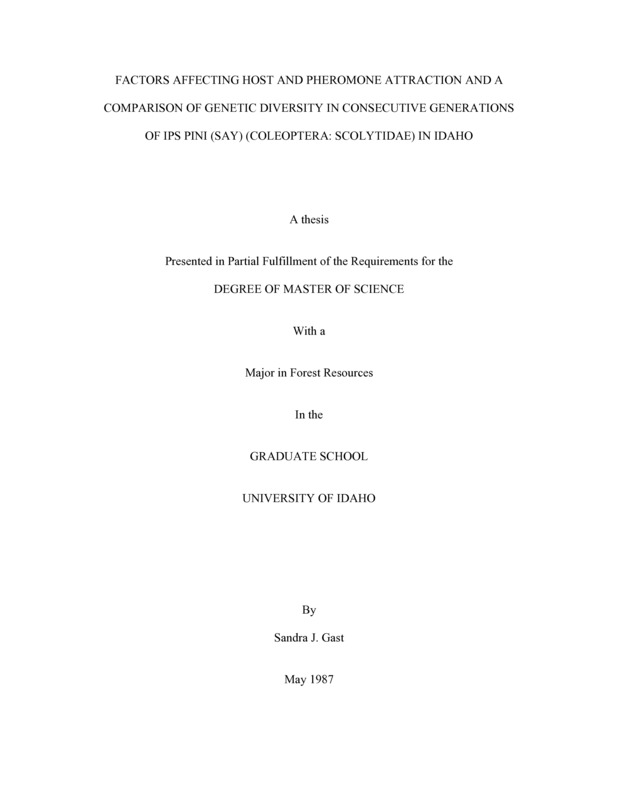PDF PREVIEW
Factors Affecting Host and Pheromone Attraction and a Comparison of Genetic Diversity in Consecutive Generations of Ips Pini (SAY) (Coleoptera: Scolytidae) in Idaho Item Info
- Title:
- Factors Affecting Host and Pheromone Attraction and a Comparison of Genetic Diversity in Consecutive Generations of Ips Pini (SAY) (Coleoptera: Scolytidae) in Idaho
- Creator:
- Gast, Sandra J.
- Date Created:
- 1987-05
- Description:
- Two consecutive generations of the pine engraver, Ips pini (say) from Idaho were studied to determine factors affecting their attraction to ponderosa pine host odors and natural male pheromone. Most beetles attracted to host pine volatiles in an arena olfactometer were desiccated males with air in their ventriculus, both of these conditions resulting from post-emergence activity, particularly flying. Most beetles attracted to male pheromone in the presence of host volatiles were desiccated, sexually mature females with air in their ventriculus and visibly fewer fat bodies than beetles that were not attracted. Factors not significantly related to host or pheromone were beetle size, abundance of phoretic mites and parasitic nematodes, and ambient barometric pressure. First-generation beetles reared in slash were more genetically heterozygous than second generation beetles reared in standing trees. Second generation beetles were more heterozygous after overwintering, presumably a result of selective mortality of poorly adapted, homozygous individuals. This study indicates that stressful conditions favor biologically fit, heterozygous individuals, and that a range of response to host and pheromone, controlled by physiological factors, enables beetles to exploit nearby and distant susceptible hosts, enhancing both survival and outcrossing among other populations.
- Document Type:
- Thesis
- Library Call Number:
- QL596.S35G3 1987
- Subjects:
- Moscow Mountain ips pini pine engraver pheromones host odor pheromone attraction genetic diversity ponderosa pine pinus ponderosa entomology
- Location:
- Moscow Mountain
- Department:
- Department of Forest Resources
- Type:
- Text
- Format:
- application/pdf
Source
- Preferred Citation:
- "Factors Affecting Host and Pheromone Attraction and a Comparison of Genetic Diversity in Consecutive Generations of Ips Pini (SAY) (Coleoptera: Scolytidae) in Idaho", UIEF Research Exchange, University of Idaho Library Digital Collections, https://www.lib.uidaho.edu/digital/uief/items/uief_0039.html
Rights
- Rights:
- In copyright, educational use permitted.
- Standardized Rights:
- http://rightsstatements.org/vocab/InC-EDU/1.0/

